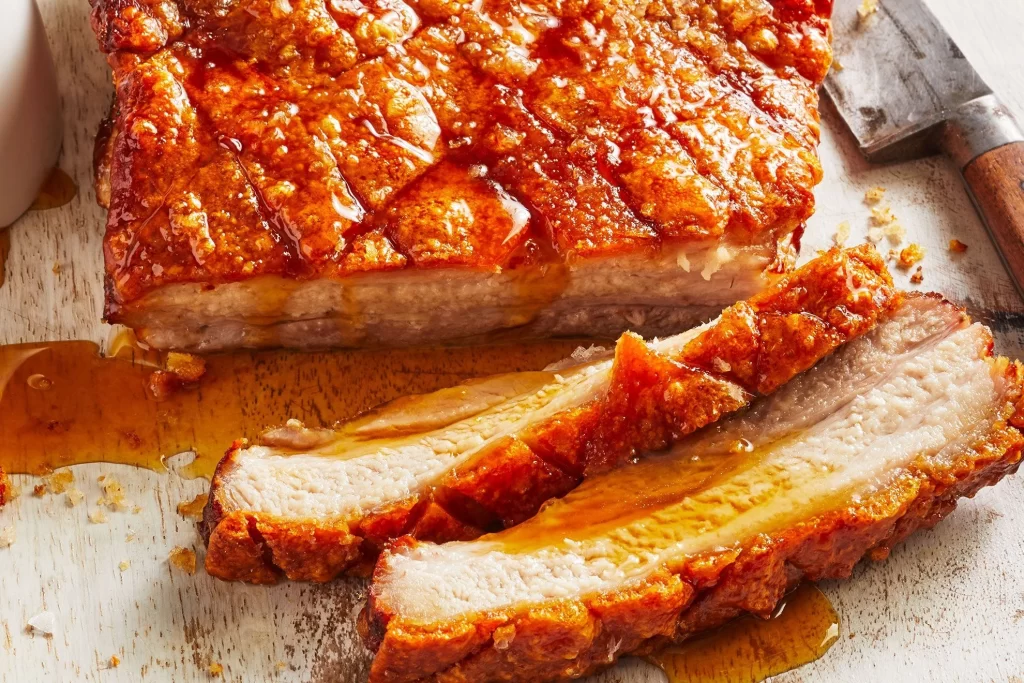You must have heard about pork belly and don’t know what it is. It might be unclear from the name whether pork comes from pigs or something else. This is not an issue that only you face. So what is pork belly? Continue reading to learn more.

What is Pork Belly?
The meat from the pig’s stomach that is boneless and rich is called pork belly. The cut appears as a brick of meat when left whole, with smaller layers of fat scattered throughout and a thick layer of flat fat running along the top.
The reason for which it is most likely famous is bacon! Pork stomach is transformed into the popular sizzling breakfast dish that everyone loves when its fatty outer layer is removed. It is then smoked, cured, and thinly sliced.
It is a traditional ingredient in Asian, Hispanic, and Northern European cuisines, where it can be the star of the show (as in a bao of pork stomach) or used as a salty garnish for other dishes (as in pancetta).
Is Pork Belly From Pig?
Yes, pigs are the source of pork belly. The ultra-rich and fatty section of meat is taken from the pig’s belly. Its preparations differ greatly from sliced streaky bacon because it is uncured and frequently sold in large slabs. World cuisines love pork stomach because it is one of the most succulent cuts of meat available.
What Does Pork Belly Taste Like?
The flavour of pork belly is rich and savoury, with hints of sweetness and salt. Cooking gives it a rich, succulent flavour because of its high fat content. The preparation method and accompaniments used when serving pork belly can affect its flavour.
The fat in the pork stomach can melt and caramelise when it is roasted or grilled, giving it a slightly sweet and slightly smoky flavour. The braising liquid, which could be anything from a savoury broth to a sweet and spicy sauce, can impart flavour to the braised pork stomach.
What is Special About Pork Belly?
Pork belly has incredible flavour! Imagine you have this wonderful cut of meat that has the ideal balance of flavour and juiciness. The meat has a delicious texture that comes from a great mixture of fat that spreads throughout.
It is a favourite among chefs and food enthusiasts because of how many different ways it can be prepared, and every bite simply melts in your mouth. Now, let’s talk about the magic of crackling. You know that layer on top, golden and crispy? That is the stuff that dreams are composed of! It is almost like an art to get it just right.
It all comes down to timing the cooking just right, controlling the temperature, and adding the ideal amount of seasonings. You get this incredible crunch with every bite when it is done just right. A foodie’s paradise!
What is Another Name for Pork Belly?
Pork belly is also known as “bacon.” Usually, bacon is made from cured and occasionally smoked pork stomach. Even though the terms are frequently used synonymously, bacon particularly refers to the cured pork stomach, which is a common ingredient in many recipes and is frequently sliced.
Other names include:
Belly Bacon Bliss:
When pork stomach is cured and smoked, it takes on a delicious new name: “belly bacon.” It enhances the already incredible flavour by adding another layer of deliciousness.
Crispy Delight: Crackling Pork:
Pork belly becomes the crispy texture we love to refer to as “crackling pork” when roasted to perfection. The crunch creates a delightful texture that accentuates the tender meat perfectly.
Asian Infusion: Samgyeopsal Magic:
Pork belly is the star of Korean cuisine, known as “samgyeopsal.” It is served with delectable sides and expertly grilled by chefs, creating a cuisine that transcends national boundaries.
Is it Healthy to Eat the Belly of Pork?
Pork stomach is a common ingredient in many international cuisines because of its succulent flavour, adaptability, and affordability. Because pork stomach consists mostly of fat, this serving size packs up to 585 calories, 60 grammes of total fat, and 22 grammes of saturated fat.
However, it’s also an excellent source of B vitamins, as well as a source of other important nutrients such as vitamin E, zinc, iron, and copper.
Plus, pork stomach is very low in sodium, providing only 36.2 mg per serving. Some recipes may boost the sodium content, so take note of how you prepare your pork stomach. It might be best to limit your intake of pork stomach to special occasions and small portions if you enjoy it.
How to Make Pork Belly?
Here’s a simple recipe for making pork belly:
➛ Season all sides of the pork stomach with salt, pepper, and any desired herbs or spices like garlic, rosemary, or thyme.
➛ Heat a large oven-safe skillet or roasting pan over medium-high heat. Add hot olive oil to the pan.
➛Place the pork belly in the pan and brown it on all sides, taking about 2-3 minutes per side.
➛ Transfer the pan to the preheated oven and roast the pork stomach for 45–60 minutes until it becomes tender and thoroughly cooked.
➛ Take the pork stomach out of the oven and let it rest for a few minutes before slicing and serving. Enjoy it on its own or use it as a tasty ingredient in sandwiches, salads, or stir-fries.
➛ Cooking and preparing pork stomach can be done in various ways, ensuring a flavorful dish that your guests will undoubtedly relish.
In conclusion, Fresh pork belly is frequently served in tiny portions and is succulent and flavorful. Slow cooking techniques, like braising, yield the tastiest and most succulent pork stomach. Chefs at restaurants love to serve pork stomach because of its flavour, texture, and versatility.

